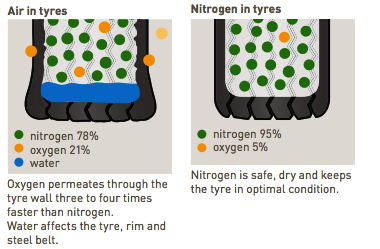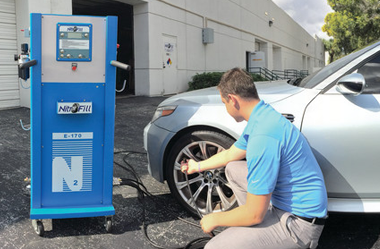
The Benefits of Nitrogen 
Air in Your Tyres
Compressed air – the traditional medium for inflating car tyres – contains both oxygen (21%) and nitrogen (78%). A rubber tyre is like a membrane, through which oxygen permeates three times faster than nitrogen. As a result, the oxygen slowly leaks out through the rubber walls, which leads to under-inflation. This in turn leads to higher tyre wear, decreased safety and comfort, and higher fuel costs. In addition, compressed air contains high levels of moisture, which can accelerate the corrosion of the tyre rim.
Tyres Inflated With Nitrogen
Nitrogen is used in tyres to avoid air leaking through the tyre wall, which results in under-inflation. The reason why nitrogen is used is because it is easy to produce, does not support combustion, has no smell and is also a component of atmospheric air. The difference between the pressure in a tyre and the pressure outside causes oxygen to permeate through the tyre. If we can create the same concentration of oxygen inside and outside tyre (equal partial pressure) then oxygen is not forced to leak through the tyre wall. Using nitrogen in tyres maintains the correct pressure, and reduces all the problems associated with under-inflation.
Why use Nitrogen?
- Less inflation pressure loss
- Reduced wheel corrosion
- Prevents inner-liner rubber deterioration by oxidation
- Tyres run cooler
- Increases tread life
- Increases fuel mileage
- Helps prevent uneven wear
- Oxygen in compressed air permeates through the wall of the tyre, thus reducing the tyre's inflation pressure. During its journey through the tyre wall.
- Oxygen oxidizes the rubber compounds in the tyre, causing under-inflation and deterioration of the rubber. Dry nitrogen will maintain proper inflation
- Pressure and will prevent auto-ignition, will not corrode rims, extends valve core life, and will help the tyre to run cooler.


